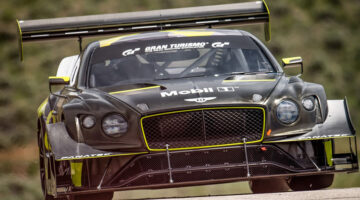So it makes commercial sense. But how do you go about building a race car in house, 10 years after you last worked on one? Things have moved on considerably in a decade. Bentley decided to establish a motorsport department in-house in Crewe, but also work with a specialist partner. But not an established endurance race team – instead, they signed a deal with Malcolm Wilson’s M-Sport, a respected rally outfit.
“This programme is very different from Le Mans because we’re basing it on road cars,” says Brian Gush, who worked on the road car’s chassis and powertrains before heading up the new motorsport department. “Because we’re using road car components – the engine has all series components in – we used the road car expertise, so we could pull all the engineers in from the line. For the body structure, the chassis set up and most importantly the electronics, we could pull guys in to come and work on the programme.
“But then also it’s got specialist components so we selected M-Sport as a technical partner, based in Cumbria also in the north west. So we have a design office there and a design office in Crewe. The engine comes off the line and is prepared in Crewe, body panels come from Crewe and we put the roll cage in up in Cumbria, so it’s a real collaboration between the two operations.
“The decision to go with M-Sport was about doing something different. I wanted an operation that worked with us, and didn’t just say ‘we’ve done this before, leave us alone, we’ll get on with it’. I wanted someone that would develop with us.
“There are a lot of technological crossovers between WRC and GT racing, such as the philosophy of ‘bend it, don’t break it’ – get to the end of the stage and repair it if there’s an accident. It’s the same in GT – get back to the pits and repair. If you stop, it’s game over. Fragility is not an option. I wanted someone that would produce a robust car.”
Bentley has produced the car quickly, turning it around in about six months since the project was okayed followed a positive reaction to last year’s concept car.
“The concept car was based on the 12-cylinder engine and was still four-wheel drive,” says Ashley Mason, the project’s liaison engine manager. “As a concept it had to look right on the outside but on the inside it just had to be able to move on and off the stand. This car however is quite different.”
The race car proper has the 4-litre V8 engine used in the road car, tuned to 600bhp, and is rear-wheel drive, with a rear-mounted six-speed Xtrac sequential transmission. The engineers have stripped more than 1000kg from the road car to get it down to a race weight of under 1300kg. As well as shifting the transmission to the rear, the engine has been moved back 400mm to ensure perfect weight balance, and the alternator and starter motor have been sent to the rear as well.
“For the rules and regulations you have to carry a common underframe, so it has to be based on a Continental GT,” explains Ashley Mason. “You can’t just throw it all away and make a carbon monocoque. So all the underside of the car is based on the Continental GT, but all the panels can be changed to carbon. So it looks like the standard car, with a cage stipulated by the FIA.”
STORY CONTINUED ON PAGE 3



